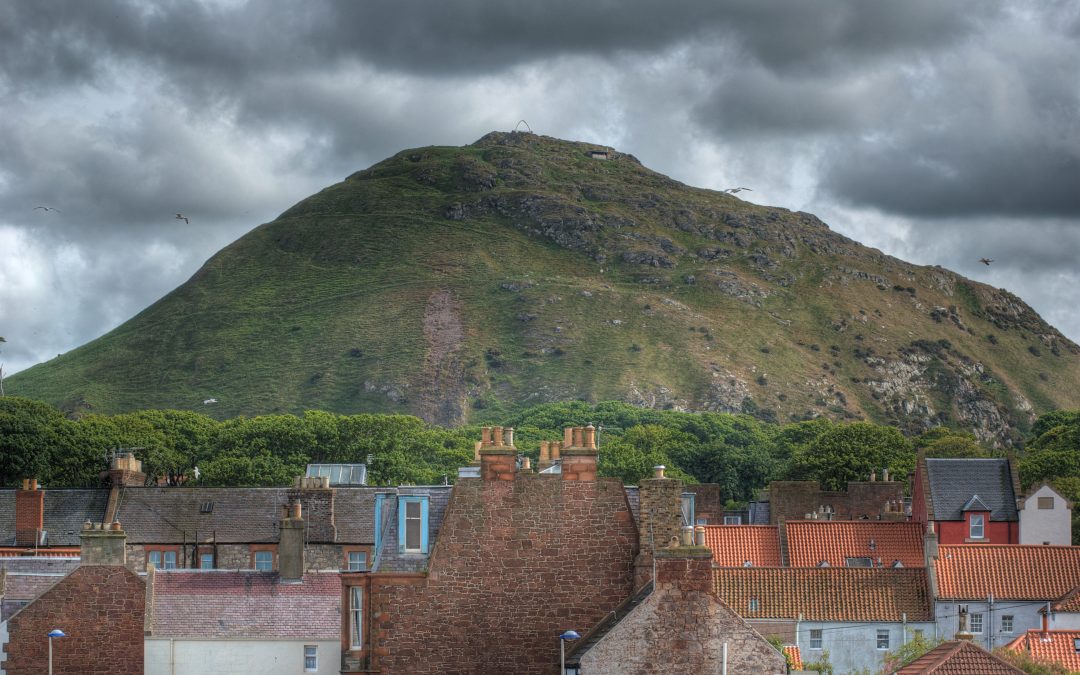Berwick Law, as it is also known, is an ancient volcanic plug that dates back over 300 million years. Its distinctive shape and location have made it an important landmark throughout history, with evidence of human activity on the hill dating back to the Iron Age. Today, visitors can explore the remains of an Iron Age hill fort on the summit, as well as a more recent Napoleonic-era signal station.
North Berwick Law is an important part of the local landscape and culture, with a rich history and unique geological features. Whether you’re looking for a challenging hike or simply want to take in the stunning views, the hill is a must-visit destination for anyone exploring the East Lothian region.
Geographical Overview
Location and Access
North Berwick Law is a prominent hill located in East Lothian, Scotland. It is situated on the north side of the Firth of Forth, approximately 32 kilometres east of Edinburgh. The hill is easily accessible by road via the B1347 and the A198. Visitors can also reach the area by rail, with North Berwick station located nearby.
Terrain and Topography
The North Berwick Law is a volcanic plug that rises 187 meters above sea level. It is a prominent landmark on the coast and can be seen from miles away. The hill is located on the south side of the Firth of Forth and is surrounded by beautiful scenery. The terrain is mostly grassy and rocky, with some steep sections. The western side of the hill is steeper than the other sides and is a popular spot for rock climbing.
Historical Significance
Prehistoric and Medieval Era
North Berwick Law has been an important landmark for thousands of years. The hill itself is an Iron Age hill fort, which was built around 2,000 years ago. It is believed that the hill was used as a lookout point to protect the local area from invaders.
During the medieval period, North Berwick Law was used as a signal point. Fires were lit on the top of the hill to warn of impending danger, such as an invasion. In addition, the hill was used as a navigational aid for ships sailing along the coast.
Napoleonic Wars to World War II
During the Napoleonic Wars, North Berwick Law was used as a signal station. The hill was an important part of the coastal defence system, and it was used to warn of any approaching enemy ships.
In World War II, the hill was once again used as a lookout point. The local Home Guard had a lookout post on the summit, and the hill was used to monitor the skies for any enemy planes.
Natural Features
Volcanic Plug and Glaciers
North Berwick Law is a hill that stands at 187m high, located in East Lothian, Scotland. It is a volcanic plug that was formed around 350 million years ago during the Carboniferous period. The plug was created when magma from a volcanic eruption cooled and solidified into a hard rock.
During the last Ice Age, glaciers covered much of Scotland, including North Berwick Law. As the glaciers moved, they eroded the surrounding landscape, leaving behind the distinctive shape of the hill. Today, visitors can see evidence of the glaciers in the form of glacial striations on the rocks.
Flora and Fauna
North Berwick Law is home to a variety of flora and fauna. The hill is covered in grasses, heather, and wildflowers, providing a habitat for a range of insects, birds, and mammals. Visitors may be lucky enough to spot Exmoor ponies grazing on the hillside. These ponies are hardy and well-suited to the rugged terrain.
The Ascent
Hiking Paths
North Berwick Law is a prominent hill that rises 613ft above sea level. The hill offers a moderately challenging hike with an easy walk at the beginning that turns into a steep climb as you approach the summit. The path is well marked and maintained, making it easy to navigate.
The ascent begins with a gentle walk through a field before reaching a rough and rocky path. As you continue to climb, the path becomes steeper, and you will need to scramble over some rocky sections. The final part of the ascent is particularly steep, and the path can be icy in winter, so it’s essential to wear appropriate footwear.
Views from the Summit
The views from the summit are breathtaking and make the ascent well worth the effort. On a clear day, you can see for miles, with views of Edinburgh, the Firth of Forth, and the surrounding countryside. There are also information boards at the summit that provide details about the history and geology of the area.
Landmarks and Monuments
Whale’s Jawbone
One of the most iconic landmarks in North Berwick Law is the Whale’s Jawbone. This structure is a fibreglass replica of a whale’s jawbone that was installed in 2000 to replace the original whale bone, which had deteriorated over time. The Whale’s Jawbone serves as a symbol of the town’s whaling past and is a popular spot for taking photos.
Lookout
The Lookout is another popular attraction in North Berwick Law. It is a stone building that was constructed in the 19th century and was used as a lookout for ships. Visitors can climb to the top of the Lookout to enjoy panoramic views of the surrounding area. The Lookout is a great spot for taking photos and is a must-visit for anyone interested in history or architecture.
Trig Point
The Trig Point is a concrete pillar that was used in the past for mapping and surveying. It is located at the highest point of North Berwick Law and offers stunning views of the surrounding countryside. The Trig Point is a popular spot for hikers and is a great place to take in the natural beauty of the area.
Nearby Attractions
John Muir Way
The John Muir Way is a 134-mile long-distance trail that runs from Helensburgh in the west to Dunbar in the east. The trail passes through some of the most stunning landscapes in Scotland, including woodlands, coastlines, and historic towns. You can access the trail from North Berwick Law, and it’s a great way to explore the local area on foot or by bike.
Scottish Seabird Centre
The Scottish Seabird Centre is a world-renowned conservation and education centre located in North Berwick. The centre offers a range of interactive exhibits, live cameras, and boat trips to the nearby islands to see some of Scotland’s most iconic seabirds, including puffins, gannets, and kittiwakes.
Tantallon and Dirleton Castles
Tantallon Castle and Dirleton Castle are two of the most impressive castles in Scotland, located just a short drive from North Berwick Law. Tantallon Castle is a 14th-century fortress perched on a cliff overlooking the North Sea, while Dirleton Castle is a 13th-century castle surrounded by beautiful gardens.
Practical Information
Parking and Public Transport
North Berwick Law is a popular tourist destination, and it is important to plan your visit in advance. If you are driving, there are several parking areas available in the town. The nearest car park to North Berwick Law is located on Quality Street, just off the High Street. From there, it is a short walk to the steps leading up to the summit.
If you are travelling by public transport, North Berwick has excellent rail and bus links. The nearest train station is North Berwick, which is located just over a mile from the town centre. From there, you can catch a bus or taxi to the foot of North Berwick Law. The local bus service also has a stop on the High Street, which is just a short walk from the steps leading up to the summit.
Visitor Facilities
There are no visitor facilities located on North Berwick Law itself, so it is important to come prepared. The steps leading up to the summit can be steep and challenging, so it is recommended that you wear appropriate footwear and clothing. It is also important to bring plenty of water and snacks, as there are no refreshment facilities available on the hill.
North Berwick is a popular seaside resort, and there are plenty of facilities available in the town centre. There are several shops and cafes located on the High Street, as well as a sports centre and a school. If you are looking for more information about the area, the local tourist information centre is located on Quality Street, just a short walk from the parking area.
To find your way around North Berwick, you can use Google Maps or pick up a map from the tourist information centre.
Cultural Significance
Arts and Festivals
North Berwick Law has been a source of inspiration for many artists over the years. The stunning views from the top of the hill have been captured in paintings, photographs and other forms of artwork. The North Berwick Art Trail is an annual event that showcases the work of local artists and provides an opportunity for visitors to explore the town’s artistic heritage.
The North Berwick Highland Games is another popular event that celebrates the town’s Scottish heritage. The games feature traditional Scottish sports such as caber tossing, tug of war and the famous Highland dancing. The event attracts visitors from all over the world and is a highlight of the local calendar.
Sports and Recreation
North Berwick Law is a popular destination for golfers, with several courses in the area offering stunning views of the hill and the surrounding coastline. The North Berwick Golf Club is one of the oldest in the world, and has hosted many prestigious tournaments over the years.
For those who prefer more active pursuits, there are plenty of opportunities for hiking, cycling and water sports in the area. Boat trips are a popular way to explore the coastline and see the local wildlife, including seals, dolphins and seabirds.
North Berwick Law has also played a role in the history of aviation. In 1910, the first flight in Scotland took place from the top of the hill, when a local aviator named Robert Loraine flew his biplane off the summit.

